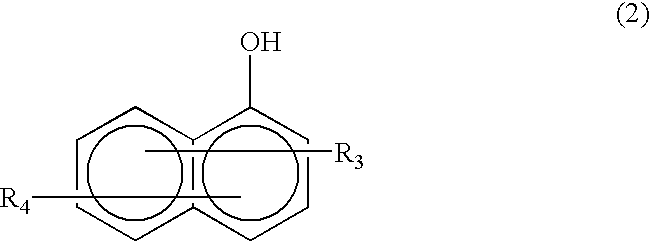Aromatic polycarbonate, production method and molded products thereof
a technology of aromatic polycarbonate and molded products, which is applied in the field of aromatic polycarbonate, production methods and molded products thereof, can solve the problems of reduced molecular weight, inability to achieve durability and stability, and inability to meet the durability and stability requirements of aromatic polycarbonates
- Summary
- Abstract
- Description
- Claims
- Application Information
AI Technical Summary
Benefits of technology
Problems solved by technology
Method used
Image
Examples
example 1
The aromatic polycarbonate obtained in Comparative Example 1 was dissolved in 1.5.times.10.sup.3 parts by weight of NMP for the electronic industry, 1.1.times.10.sup.-4 parts by weight of methanol for the electronic industry was added to separate the precipitated polymer by filtration, and the polymer was dried at 13.3 Pa (0.1 mmHg) and 100.degree. C. for 24 hours. The obtained aromatic polycarbonate had a viscosity average molecular weight of 15,300, a terminal hydroxyl group concentration of 85, a phenoxy terminal group concentration of 154 (eq / ton-polycarbonate) and a melt viscosity stability of 0.
example 2
2-methoxycarbonylphenylphenyl carbonate (to be abbreviated as SAM hereinafter) was added in an amount of 8.0.times.10.sup.-3 part by weight based on 1 part by weight of a polymer when the viscosity average molecular weight of a polycarbonate became 15,300 in the production of the polycarbonate in Comparative Example 1 and stirred at 260.degree. C. and 133.3 Pa (1 mmHg) for 10 minutes. Thereafter, 2.3.times.10.sup.-6 part by weight of DBSP was added and stirred at 260.degree. C. and 66.7 Pa (0.5 mmHg) for 10 minutes.
The obtained aromatic polycarbonate was dissolved in 1.5.times.10.sup.3 parts by weight of NMP for the electronic industry, 1.1.times.10.sup.4 parts by weight of methanol for the electronic industry was added to separate the precipitated polymer by filtration, and the polymer was dried at 13.3 Pa (0.1 mmHg) and 100.degree. C. for 24 hours. The obtained aromatic polycarbonate had a viscosity average molecular weight of 15,300, a terminal hydroxyl group concentration of 60,...
example 3
The procedure of Example 2 was repeated except that SAM was used in an amount of 17.6.times.10.sup.-3 part by weight based on 1 part by weight of the polymer. The obtained aromatic polycarbonate had a viscosity average molecular weight of 15,300, a terminal hydroxyl group concentration of 30, a phenoxy terminal group concentration of 209 (eq / ton-polycarbonate) and a melt viscosity stability of 0.
PUM
| Property | Measurement | Unit |
|---|---|---|
| pore diameter | aaaaa | aaaaa |
| length | aaaaa | aaaaa |
| inner diameter | aaaaa | aaaaa |
Abstract
Description
Claims
Application Information
 Login to View More
Login to View More - R&D
- Intellectual Property
- Life Sciences
- Materials
- Tech Scout
- Unparalleled Data Quality
- Higher Quality Content
- 60% Fewer Hallucinations
Browse by: Latest US Patents, China's latest patents, Technical Efficacy Thesaurus, Application Domain, Technology Topic, Popular Technical Reports.
© 2025 PatSnap. All rights reserved.Legal|Privacy policy|Modern Slavery Act Transparency Statement|Sitemap|About US| Contact US: help@patsnap.com



